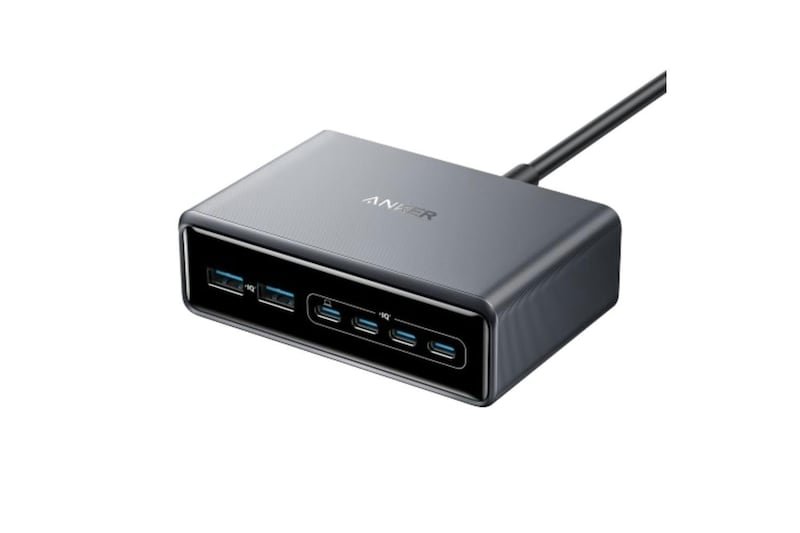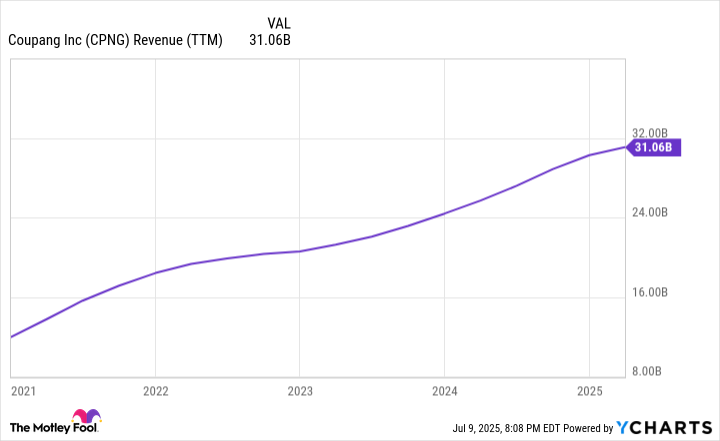Tools & Platforms
Why Coupang Just Became a Must-Own AI Stock in the Technology Sector

The company is entering the lucrative AI cloud computing market.
Another technology player just got into the artificial intelligence (AI) game. Coupang (CPNG -1.22%) recently unveiled its new intelligent cloud computing service focused on AI, which is vying for government funding as South Korea aims to become a cloud computing hub. The e-commerce platform is expanding into another technology field, giving the company an even longer runway to grow.
Similar to Amazon, Coupang has begun in e-commerce and has now taken those resources to build a cloud computing service. Here’s why Coupang just became a must-own stock in the technology sector.
Image source: Getty Images.
AI cloud computing in Korea
According to its press release, Coupang has been investing in AI computing infrastructure for years to power its warehouses, website analytics, and logistics network. Now, it is beginning to outsource its data centers to third parties. Named the Coupang Intelligent Cloud (CIC), earlier this month management officially unveiled the division, which is a major departure from its commerce platform.
It is curious timing — and perhaps not coincidental — to have this announcement come right around when the government of South Korea plans to spend $1 billion on a GPU cluster for AI in Seoul. Coupang is one of the companies vying for this contract, which could kick-start growth for this new endeavor. As a Korean company, the government of South Korea is more likely to choose Coupang for this deal, making it one of the potential candidates to win the contract.
Cloud computing is a huge and lucrative market, which makes it an exciting sector for Coupang to tackle. Just take a look at Amazon, which generates more than $100 billion in revenue from its cloud computing division. This won’t happen to Coupang overnight, but the company just massively expanded its addressable market by entering a sector that is now supercharged by the AI revolution.
Taking earnings and reinvesting in hypergrowth
In e-commerce, Coupang still has plenty of room left to expand its operations in South Korea. Its revenue from its original e-commerce marketplace grew 16% year over year last quarter to $6.9 billion, and is still a small slice of the total Korean retail market. With $2 billion in annual operating cash flow, Coupang is now a self-sustaining operator, which gives it the flexibility to reinvest into new revenue segments.
And boy, is it ever reinvesting. It has the newly introduced cloud segment, which can take a lot of capital expenditures as the company looks to build new data centers. There is food delivery, financial technology, video streaming, advertising, and the Farfetch luxury marketplace it just acquired. Most important may be the geographic expansion into Taiwan, which has accelerated revenue growth at the company’s “developing offerings” segment to 78% year over year on a foreign currency neutral basis. The segment now does $1 billion in quarterly revenue and should become an increasingly important part of the overall Coupang business in the next few years.
CPNG Revenue (TTM) data by YCharts
Why Coupang stock is a buy
There is reason to be highly optimistic around Coupang’s future growth prospects. Its core business is still chugging along, Taiwan and other developing offerings are growing quickly, and it just added this new cloud computing division. From my seat, this sounds a lot like Amazon in the early days, and readers are well aware of how well this stock has performed for shareholders in the last two decades.
Coupang stock is up 41% in the last year, but I think the party is just getting started. At a market cap of $55 billion, the stock trades at what looks like an expensive price-to-earnings ratio (P/E) of 215, but this is misleading compared to Coupang’s forward earnings potential. The company generates $31 billion in annual revenue and believes it can reach 10% profit margins once it stops reinvesting for growth.
Given its current revenue growth potential, I think the company can quickly get to $50 billion in revenue and eventually has a path to $100 billion in annual sales. Margins may even end up higher than 10% due to the growth of advertisements and this new cloud computing division.
That $50 billion in revenue and 10% profit margins would result in $5 billion in earnings, or a forward P/E barely over 10 compared to the stock’s current market cap. This will happen faster than investors think. Coupang stock looks like a fantastic AI stock to add to your portfolio right now.
John Mackey, former CEO of Whole Foods Market, an Amazon subsidiary, is a member of The Motley Fool’s board of directors. Brett Schafer has positions in Amazon and Coupang. The Motley Fool has positions in and recommends Amazon. The Motley Fool recommends Coupang. The Motley Fool has a disclosure policy.
Tools & Platforms
Israel’s next strategic bet is Deep Tech, not just AI
Deep Tech creates technologies that form the backbone of national defense and industrial sovereignty

Tools & Platforms
Can Generative AI transform healthcare?
Generative AI may be the fastest-adopted technology in history, but in healthcare it is still largely seen through the narrow lens of chatbots. That perception, argued experts at WHX Tech-EHS Summit in Dubai during a panel discussion, risks blinding policymakers and providers to its deeper potential, and to the barriers that stand in its way.
“It’s like saying the internet is only e-mail,” said Christian Hein, former Novartis vice-president for digital transformation. “Chatbots are just the front-end. The real power lies in what sits beneath, which is an information engine capable of synthesising scientific literature, drafting clinical trial protocols, automating reimbursement coding and extracting unstructured data from medical records.”
The discussion, moderated by health AI consultant Sigrid Berge van Rooijen, opened with a question: Is generative AI destined to remain a glorified customer-service tool?
For Tatyana Kanzaveli, founder of Open Health Network, the danger lies in merely bolting new technologies onto outdated systems. “We cannot just deploy GenAI to augment old business processes,” she said. “Imagine agentive AI predicting when MRI equipment is about to fail, ordering the part, scheduling the engineer and coordinating the fix automatically. Or a digital twin monitoring your health data, arranging prescriptions, transport and care without you lifting a finger. That is the world we should be building.”
Bharat Gera, who has spent 25 years working on digital health transformation, echoed the need for caution but also saw promise in simple tools such as summarisation. “Doctors spend huge amounts of time reading patient histories. Summarisation is a powerful use case, here and now,” he said. But he warned against overloading clinicians with alarms and unvalidated signals: “Healthcare is fundamentally human. If we forget that, technology will make things worse.”
Regulation, risk and responsibility
If technology is racing ahead, regulation is struggling to keep pace. Amil Khanzada, CEO of Virufy, highlighted how laws differ dramatically across jurisdictions. “In Dubai, anonymised medical data cannot be sent overseas. In Pakistan, there isn’t even a privacy law yet. Patients have the right to delete their data, but what happens once that data has already trained a model? Do you retrain it from scratch?”
Consent forms, he added, are another minefield. “You can try to use generative AI to summarise them, but you still need human validation. And patients often sign without reading. The legal and ethical risks are enormous.”
Kanzaveli pointed to the dangers of misplaced trust. “Generative AI is persuasive. You trust it. But in healthcare, a wrong answer can mean a missed diagnosis, or worse. We spent longer building the risk-management framework for a virtual psychologist than we did building the engine itself. That is our responsibility.”
The human factor
Perhaps the most sobering intervention came from Anne Forsyth, Vice-Chair of Digital Health Canada and IT lead at Toronto’s Women’s College Hospital. She recounted how a cancer diagnosis was delayed for a year because test results were stuck in a hospital IT interface. “What do you tell the patient? Tech will never be perfect. We must always plan for failure,” she said. “If you are building GenAI tools for hospitals, think about what happens when they fail, and what supports clinicians will have.”
Hein agreed. “Technology is easy. Change is the hard part. The real work is persuading people that you are there to augment, not replace them. Without that, AI will never scale.”
A future too important to ignore
Despite their differing emphases, the panellists agreed that generative AI is already reshaping healthcare and that ignoring it is not an option. “There is no industry that can remain competitive without deploying these technologies,” Kanzaveli said. “The only question is how responsibly we do it.”
As Berge van Rooijen concluded, the challenge is not whether generative AI is more than a chatbot. It clearly is. The question is how to harness its promise without repeating the mistakes of past digital health revolutions, and without losing sight of the people at the heart of the system.
Tools & Platforms
Laptop or tablet? Plus, power packs, headphones and AI advice – The Irish Times

College students are coming back to their lecture halls this week or starting out on their third-level studies. If you are an incoming first year, there is plenty to get to grips with, from reading lists and schedules to travel passes and finding your way around the campus.
On top of that, you probably have some extra technology requirements. Perhaps a laptop upgrade is on the cards or you might think of investing in a tablet.
So what are the tech essentials and what are simply nice to have?
Laptops
The laptop is not yet dead, despite some predictions of its demise. In fact, things seem to be going well for the device the tablet was supposed to replace.
Picking the right one can be difficult, though; you need to strike a balance between a laptop that will last a few years and not overpaying for technology you don’t actually need. In other words, the top-spec machines are great but they aren’t necessary for everyone.
There are some things to consider before you make your choice. First is the size of the device. If you plan on carrying it around everywhere, something reasonably compact and light is best. Most people find the 13- to 14-inch screens offer the best balance in terms of portability while still giving you enough room to work with.
That should cover you for creating documents, browsing online, editing images and videos, and creating content for your social channels if that is what you are into.
For those who need something with a bit more screen space – for design, perhaps – a 15-inch display might suit better, but will be more clunky to carry around.
Once you have decided on the size, it is time to look at its main components. Think of the processor as the brain of the computer. On a budget, the AMD Ryzen 3 series or Intel Core i3 will be fine for web browsing and word processing.
Moving up the chain, AMD’s Ryzen 5 offers a good balance of performance and efficiency, comparable to the Intel Core i5 chip. For more demanding tasks, the Ryzen 7 or Core i7 chips are worth considering, although they will incur a higher cost.
Then you get into RAM, which will allow your computer to deal with heavier workloads and run more tasks at once without stuttering to a halt. Windows requires a minimum of 4GB. Bumping it to 8GB is sufficient for basic workloads.
To ensure your computer lasts longer, consider upgrading to 16GB if possible. Video editing, photo editing, gaming and other power-hungry applications will need more RAM, so consider your future needs too.
And when it comes to on-board storage, aim for 512GB if you can. You can supplement it with external and cloud storage, but that requires either carrying around a second device – not ideal if you want to stay mobile – or an internet connection, which isn’t always possible.
Mac versus Windows is the ongoing battle, but ChromeOS is also an option for students on a budget, or Linux if you are technically inclined. The decision will ultimately depend on what software you need to run. If you have no specific requirements, then your choices are much wider. Some students will need to run specific software for their course – computer-aided design programmes, for example – that will have minimum system requirements.
Power
If you have a new-ish laptop with a power-efficient chip, you probably won’t run into too many issues with your device’s battery. But occasionally, they take a battering, and when you find your battery dwindling to alarming levels, having some sort of backup is handy.
Doing more with less is a good approach, and these days most devices can be charged over USB-C, thanks to some heavy nudges from the European Commission. In theory, you could carry one charger in your bag and power all your devices at various times throughout the day.
If you need more than one device charged, though, something with multiple USB options is a good idea. Take the Anker GaNPrime 200W Charger (€90, Harvey Norman). Not only does it charge both USB-A and USB-C devices, it can also power up to six devices simultaneously.
It has a total power rating of 200W, which means you can charge two 14-inch MacBook Pro devices in under half an hour or several USB-C-enabled smartphones simultaneously. It also has a built-in protection system to make sure your devices charge safely and at a suitable temperature.
However, there will inevitably be a time when you are away from a power outlet and caught with a low battery. The Chargeasap Flash Pro Plus ($200, chargeasap.com), a graphene 25000mAh battery, cannot only charge your smartphone and Apple Watch, but also your laptop.

Noise-cancelling headphones
If you don’t already own a pair of these, you need to invest in some, asap. Not only can they help you to block out the bus noise on the commute home, they may also save your sanity in the library around exam time. Among the best in the over-ear category are the Sony WH-1000XM6 (€450, Currys).
Apple users may prefer the in-ear AirPods Pro (€279, Apple), but there are plenty of options out there that will cross the platform barrier and work with your laptop too, such as the Bose QuietComfort Active ear buds (€150, Harvey Norman)

If you are just in need of some decent earplugs without any added distraction, however, the Loop Quiet 2 (€20, Loop.eu) will block out enough noise to help you focus.

AI
Artificial intelligence is creeping into our daily lives, from AI-enabled chatbots talking us through customer service nightmares to research assistants that can create podcasts from our documents and debate the finer points of our research topic.
The capabilities out there vary, however. Apple is still trailing slightly on AI integration. although devices such as the iPhone 15 Pro and Pro Max, and newer models, support the handful of Apple Intelligence features that have been launched in Europe. That includes tools to manage your inbox, refine messages and documents, and edit photographs. Broader searches call in ChatGPT.
Samsung and Google have taken it a step further. Gemini, Google’s AI-enabled assistant, has now become the default assistant on your smartphone, with its latest Gemini machine learning models and chatbots integrated into the system.
There are other ways to use AI, however, assuming your college course allows it. Grammarly, for example, will help you polish up college projects and essays, while also keeping an eye out for potential plagiarism, assuming you take out the Pro subscription at €144 for the year. Its verdict on this article, for example, was a resounding “zero copied text”.
[ I have advice for prospective third-level students, and it’s not what you thinkOpens in new window ]
ChatGPT, meanwhile, can help you research a specific topic with its latest GPT-5 model which, according to founder Sam Altman, has “PhD level intelligence”. Whether you buy into that or not, ChatGPT can be a handy research partner. Just remember, as with all AI, to check up on its sources before you believe what it tells you.
The current favourite AI-enabled tool around here though is Google’s NotebookLM. Free to use, you can create notebooks for research topics with up to 50 sources each. The AI will then analyse the sources and explain it to you in bullet points, create an FAQ-style sheet or study guide, or even generate an AI podcast, where two synthetic hosts discuss the topic in detail.
-

 Business2 weeks ago
Business2 weeks agoThe Guardian view on Trump and the Fed: independence is no substitute for accountability | Editorial
-
Tools & Platforms4 weeks ago
Building Trust in Military AI Starts with Opening the Black Box – War on the Rocks
-

 Ethics & Policy2 months ago
Ethics & Policy2 months agoSDAIA Supports Saudi Arabia’s Leadership in Shaping Global AI Ethics, Policy, and Research – وكالة الأنباء السعودية
-

 Events & Conferences4 months ago
Events & Conferences4 months agoJourney to 1000 models: Scaling Instagram’s recommendation system
-

 Jobs & Careers2 months ago
Jobs & Careers2 months agoMumbai-based Perplexity Alternative Has 60k+ Users Without Funding
-

 Education2 months ago
Education2 months agoMacron says UK and France have duty to tackle illegal migration ‘with humanity, solidarity and firmness’ – UK politics live | Politics
-

 Education2 months ago
Education2 months agoVEX Robotics launches AI-powered classroom robotics system
-

 Podcasts & Talks2 months ago
Podcasts & Talks2 months agoHappy 4th of July! 🎆 Made with Veo 3 in Gemini
-

 Funding & Business2 months ago
Funding & Business2 months agoKayak and Expedia race to build AI travel agents that turn social posts into itineraries
-

 Podcasts & Talks2 months ago
Podcasts & Talks2 months agoOpenAI 🤝 @teamganassi


